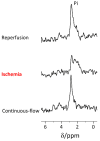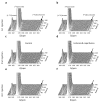LDH and PDH Activities in the Ischemic Brain and the Effect of Reperfusion-An Ex Vivo MR Study in Rat Brain Slices Using Hyperpolarized [1-13C]Pyruvate
- PMID: 33808434
- PMCID: PMC8066106
- DOI: 10.3390/metabo11040210
LDH and PDH Activities in the Ischemic Brain and the Effect of Reperfusion-An Ex Vivo MR Study in Rat Brain Slices Using Hyperpolarized [1-13C]Pyruvate
Abstract
Ischemic stroke is a leading cause for neurologic disability worldwide, for which reperfusion is the only available treatment. Neuroimaging in stroke guides treatment, and therefore determines the clinical outcome. However, there are currently no imaging biomarkers for the status of the ischemic brain tissue. Such biomarkers could potentially be useful for guiding treatment in patients presenting with ischemic stroke. Hyperpolarized 13C MR of [1-13C]pyruvate is a clinically translatable method used to characterize tissue metabolism non-invasively in a relevant timescale. The aim of this study was to utilize hyperpolarized [1-13C]pyruvate to investigate the metabolic consequences of an ischemic insult immediately during reperfusion and upon recovery of the brain tissue. The rates of lactate dehydrogenase (LDH) and pyruvate dehydrogenase (PDH) were quantified by monitoring the rates of [1-13C]lactate and [13C]bicarbonate production from hyperpolarized [1-13C]pyruvate. 31P NMR of the perfused brain slices showed that this system is suitable for studying ischemia and recovery following reperfusion. This was indicated by the levels of the high-energy phosphates (tissue viability) and the chemical shift of the inorganic phosphate signal (tissue pH). Acidification, which was observed during the ischemic insult, has returned to baseline level following reperfusion. The LDH/PDH activity ratio increased following ischemia, from 47.0 ± 12.7 in the control group (n = 6) to 217.4 ± 121.3 in the ischemia-reperfusion group (n = 6). Following the recovery period (ca. 1.5 h), this value had returned to its pre-ischemia (baseline) level, suggesting the LDH/PDH enzyme activity ratio may be used as a potential indicator for the status of the ischemic and recovering brain.
Keywords: brain slices; dissolution dynamic nuclear polarization; ischemic stroke; lactate dehydrogenase; pyruvate dehydrogenase; reperfusion.
Conflict of interest statement
The authors declare no conflict of interest.
Figures





Similar articles
-
The metabolic representation of ischemia in rat brain slices: A hyperpolarized 13 C magnetic resonance study.NMR Biomed. 2021 Jul;34(7):e4509. doi: 10.1002/nbm.4509. Epub 2021 Mar 28. NMR Biomed. 2021. PMID: 33774865
-
Real-time influence of intracellular acidification and Na+ /H+ exchanger inhibition on in-cell pyruvate metabolism in the perfused mouse heart: A 31 P-NMR and hyperpolarized 13 C-NMR study.NMR Biomed. 2023 Oct;36(10):e4993. doi: 10.1002/nbm.4993. Epub 2023 Jul 10. NMR Biomed. 2023. PMID: 37424280
-
Correlation between lactate dehydrogenase/pyruvate dehydrogenase activities ratio and tissue pH in the perfused mouse heart: A potential noninvasive indicator of cardiac pH provided by hyperpolarized magnetic resonance.NMR Biomed. 2021 Feb;34(2):e4444. doi: 10.1002/nbm.4444. Epub 2020 Dec 1. NMR Biomed. 2021. PMID: 33258527
-
Pyruvate dehydrogenase complex in cerebral ischemia-reperfusion injury.Brain Circ. 2016 Apr-Jun;2(2):61-66. doi: 10.4103/2394-8108.186256. Epub 2016 Jul 13. Brain Circ. 2016. PMID: 30276274 Free PMC article. Review.
-
Regulation by carnitine of myocardial fatty acid and carbohydrate metabolism under normal and pathological conditions.Basic Res Cardiol. 2000 Apr;95(2):75-83. doi: 10.1007/s003950050167. Basic Res Cardiol. 2000. PMID: 10826498 Review.
Cited by
-
The impact of glycolysis on ischemic stroke: from molecular mechanisms to clinical applications.Front Neurol. 2025 Jan 24;16:1514394. doi: 10.3389/fneur.2025.1514394. eCollection 2025. Front Neurol. 2025. PMID: 39926015 Free PMC article. Review.
-
Accumulation of 3-aminopropylphosphonate in the ex vivo brain observed by phosphorus-31 nuclear magnetic resonance.NMR Biomed. 2022 Aug;35(8):e4721. doi: 10.1002/nbm.4721. Epub 2022 Mar 13. NMR Biomed. 2022. PMID: 35229366 Free PMC article.
-
Dissection of Neurochemical Pathways Across Complexity and Scale.J Neurochem. 2025 Jul;169(7):e70160. doi: 10.1111/jnc.70160. J Neurochem. 2025. PMID: 40692178 Free PMC article. Review.
-
Efficacy and safety of Shenmai injection for acute ischemic stroke: a systematic review and meta-analysis.Front Pharmacol. 2024 Jun 4;15:1394936. doi: 10.3389/fphar.2024.1394936. eCollection 2024. Front Pharmacol. 2024. PMID: 38895632 Free PMC article.
-
Association of α-HBDH levels with the severity and recurrence after acute ischemic stroke.Eur J Med Res. 2024 Jun 26;29(1):347. doi: 10.1186/s40001-024-01944-y. Eur J Med Res. 2024. PMID: 38926868 Free PMC article.
References
-
- Feigin V.L., Nichols E., Alam T., Bannick M.S., Beghi E., Blake N., Culpepper W.J., Dorsey E.R., Elbaz A., Ellenbogen R.G., et al. Global, regional, and national burden of neurological disorders, 1990-2016: A systematic analysis for the global burden of disease study. Lancet Neurol. 2019;18:459–480. doi: 10.1016/S1474-4422(18)30499-X. - DOI - PMC - PubMed
-
- Feigin V.L., Forouzanfar M.H., Krishnamurthi R., Mensah G.A., Connor M., Bennett D.A., Moran A.E., Sacco R.L., Anderson L., Truelsen T., et al. Global and regional burden of stroke during 1990-2010: Findings from the global burden of disease study. Lancet. 2014;383:245–254. doi: 10.1016/S0140-6736(13)61953-4. - DOI - PMC - PubMed
-
- Virani S.S., Alonso A., Benjamin E.J., Bittencourt M.S., Callaway C.W., Carson A.P., Chamberlain A.M., Chang A.R., Cheng S., Delling F.N., et al. Heart disease and stroke statistics-2020 update: A report from the american heart association. Circulation. 2020;141:e139–e596. doi: 10.1161/CIR.0000000000000757. - DOI - PubMed
-
- Powers W.J., Rabinstein A.A., Ackerson T., Adeoye O.M., Bambakidis N.C., Becker K., Biller J., Brown M., Demaerschalk B.M., Hoh B., et al. 2018 guidelines for the early management of patients with acute ischemic stroke: A guideline for healthcare professionals from the american heart association/american stroke association. Stroke. 2018;49:e46–e110. doi: 10.1161/STR.0000000000000158. - DOI - PubMed
Grants and funding
LinkOut - more resources
Full Text Sources
Other Literature Sources

